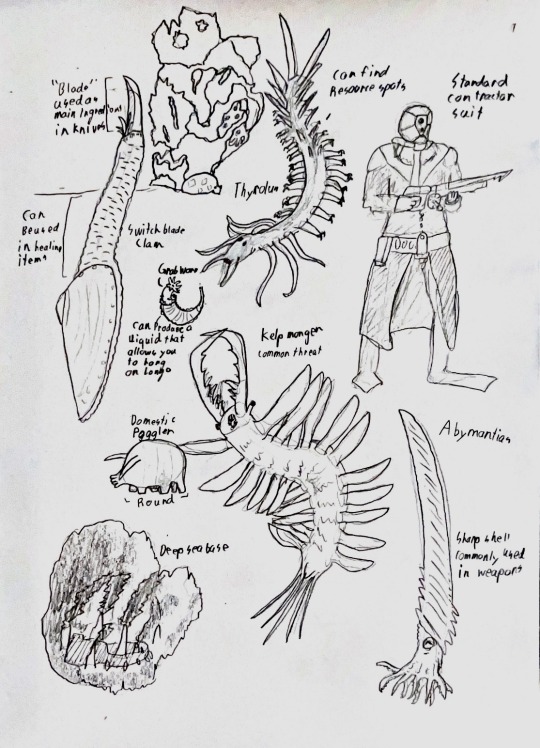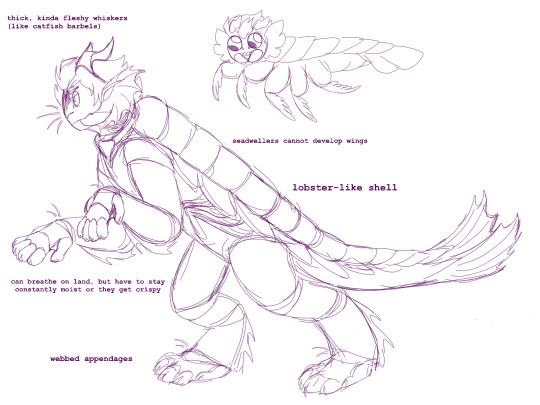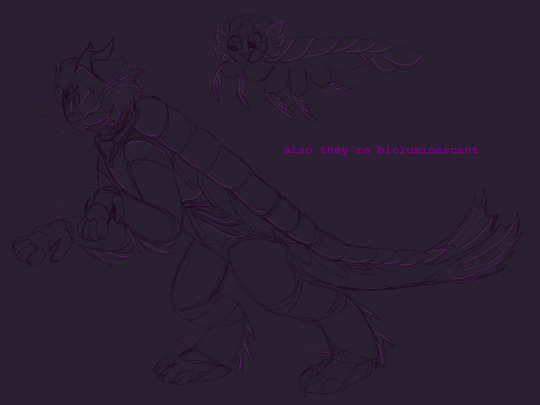Text


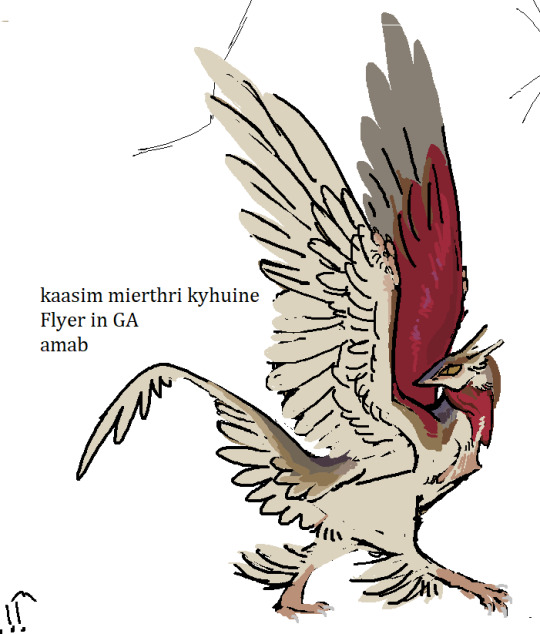
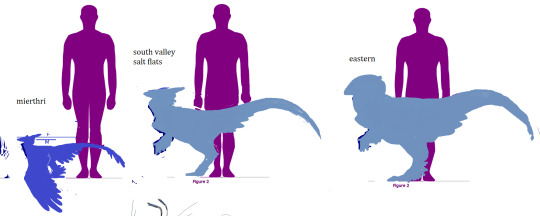

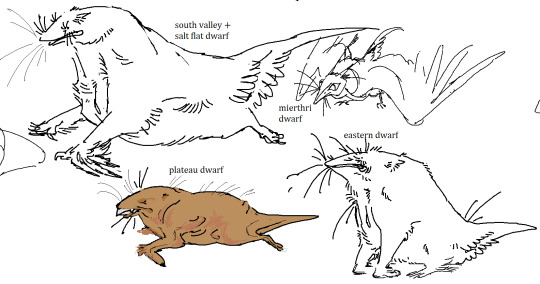
not so interesting sketch dumps cause i feel guilty about not posting today, last one is mythological kyhuine dwarves ideas




maanul faces dump, trying to have ocs with difference faces lalala
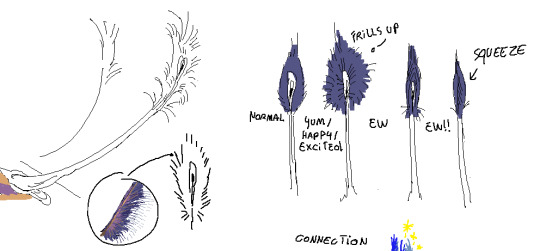
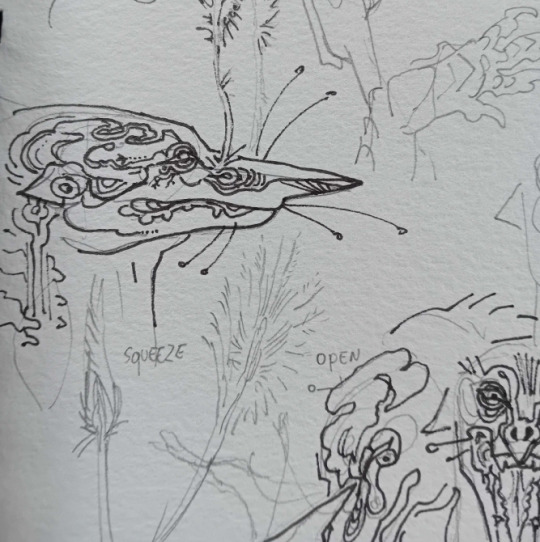
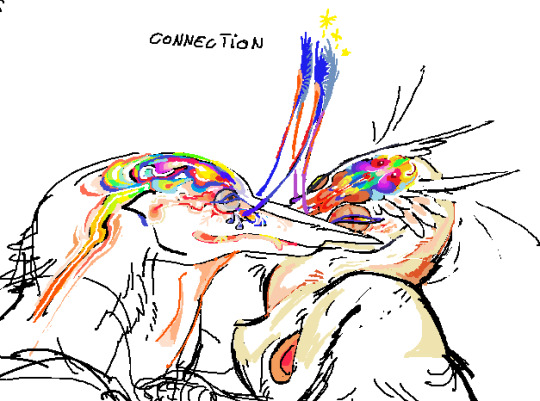
sketches for a wip text about new infos around tahofahs and how theywork, concepts about "mind gates" and exchanging infos. its already figured, already yapped to some friends about it, i just need to redo my text to be clean and coherent for normal people here
shitposts

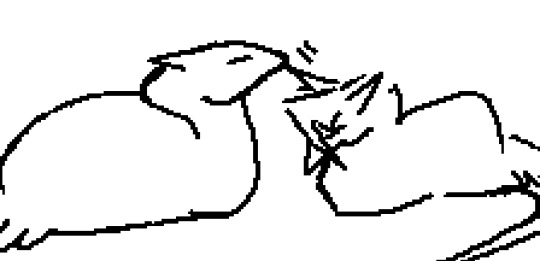

597 notes
·
View notes
Note
Are you telling me there is a third race of sophonts that flies!?!?!
🤓erm adjusts my glasses *species
there's kyhuines, which has 2 members in its species. One being the gliding population either called "mierthri" after the biome they live nearby or "red kyhuines", "deep red kyhuine" deep red being another name for the same biome. while they're different distinct species they're close enough for hybridisation but offsprings will never be able to glide
i dont know how to phrase my thoughts correctly tho, whatever if this image helps somehow, the renders are a bit ugly on some groups but its all i have now to show people

the 2 kyhuine species are considered as the same thing. even maanuls socially are considered as the same species despite how in their case they're even more different than kyhuines
94 notes
·
View notes
Text
Dragons in a Trail of Cryptids

I don't care if this technically was posted in march i uploaded it to deviant art in time this is a february art post lmfao. This was meant to be a birthday gift for @jennywolfgal and her other project Trail of Cryptids. Enjoy!!!
The world of Trail of Cryptids explores an evolutionary history for life on earth. One in which the beasts of our folklore are more fact than fiction. Cryptids and mythological creatures exist and evolved naturally through both expected and unexpected origins.
One such group of organisms are the legendary dragons of countless tales of our world. Here they only recently diversified, but their ancestry dates all the way back to the beginning of the triassic.
Their earliest ancestor was a third offshoot of the Avemetatarslians, the same group of archosaurs that gave rise to the dinosaurs and pterosaurs. Ancient Silesaur-like Paradrakoans lived under their brothers’ shadows for the entire mesozoic period. Only scraping by through the smallest niches and farthest corners of the world like the equally unfortunate mammals.
Once the asteroid hit the earth 66 million years ago and wiped out the dinosaurs and pterosaurs. Only 2 representatives of this once great clade remained. Birds, and a single paradrakoan. A small burrower classified as Fodermasaurus superstes, cheekily named by paleontologists as the spug.
It took a long time for the Drakoans to grow their wings and spread it. At first climbing trees and making burrows, then gliding to ease the falls from the canopy. Then longer webbing on the hands to change direction. And finally learned to flap them to gain height. Countless now dead lineages, finally producing the first Drakoan over 40 million years ago during earth’s late eocene.
Nowadays the Drakoans are a fairly small group. They only consist of roughly 1,116 species. A far cry from their far more successful avian cousins. But nonetheless a monumental achievement relative to their entire evolutionary history.
Some common traits that distinguish the Drakoans from other vertebrates are developed egg-teeth that some species retain well into adulthood. Large auricles or external ears, Keratin horns. And most notably powered flight, evolving independently from their avian cousins.
We’ll start out with the order Avidrakoa. An order of Drakoans unique for possessing fully developed beaks derived from their egg teeth. And a unique wing structure made more out of fur bristles than a tough skin membrane. The Avidrakoans first split the moment the class as a whole first evolved powered flight. Allowing their wings to be this derived
They are not too common, numbering in 148 species in total. Most of which are split between basal bipeds such as thunderbirds and the more derived quadrupeds which include griffins.
The species here is an actual griffin. Gryphon tropicus to be exact. They are apex predators of the rainforests of indonesia. Their deep warm coloration and disruptive stripe conceal them in the forest scenery to ambush prey. And their powered flight lets them hop across islands, making them not only a formidable predator, but a widespread one too.
The most famous members of the Drakoan class are the Eudrakoans, the true dragons. They are characterized by their strong parenting mentalities and a natural ability to breathe fire. Through 4 orifices in the corners of their mouth they spew out a liquid biofuel into the path of a similarly regurgitated and highly reactive gas, igniting the fuel into a stream of flaming liquid.
They are the most widespread group of dragons, totalling at 447 different species. Most species are either small sprawling quadrupeds such as the European forest dragon to erect striding quadrupeds like the legendary Eurasian mountain Tsar
The species representing the True Dragons. Megaloros thereusicthys is a close relative to the Eurasian mountain Tsar. Although unlike their apex cousin this species is a wading piscivore. Using their stilted legs to practically hover over the water and their flexible necks to pluck fish out of the rivers they tread through.
Next up is the order Wyverna, a group of Drakoans distinguished by the development of poison laced quills found in certain places along the body. All interconnected to a set of poison glands in the upper mandible. These glands oddly enough share the same ancestry as the biofuel tanks in the Eudrakoans. And a stiffer wing structure making them obligate bipeds
They are the second most common order of dragons. Numbering at 335 documented species. Including the cockatrice surprising many.
The species pictured here is Ouranodyno chrysokephale. A generalist omnivore with a generalist range across Mexico with a rather extravagant hunting method. They dive-bomb towards their prey and catch them with their mouths. More as showmanship for mates than an actual means to survive. They also have extravagant coloration to warn would-be attackers of their poisonous tail quill that could kill a bison in under a minute
The order Neosauria is in a way, a twisted mirror of the beasts of the past. They are notable for a complete lack of wings. Reduced horns and aurica. But are most unique for their Theropod-like body plan as a consequence for their ancestor and their stiffer wings like their wyvern cousins.
They are a very rare order, the rarest order of dragons in fact. There are only about 62 species documented. Most of them are found across africa as smaller generalists. But a few can get big enough to recapture what the original dinosaurs had lost
Representing the Neosaurians, the Kasaii asymneter is a south african desert dwelling relative to the legendary Kasaii rex of the southern congo rainforest. They are both pursuit hunters and act relatively similar. The main difference is the prey selection and differenc coloration.
And finally there is the order Wurmiza, the most derived group of dragons recorded. They are distinguished by a near complete lack of hind legs. Fully internalized ears, a streamlined annelid-from body plan, and aquatic to semi-aquatic lifestyle. They are the 2nd rarest order of dragons. Consisting of only 124 documented species. Consisting of the smaller seafaring Ladons and the larger Oceanic sea Serpents.The species used to represent the Wyrms, Pachaktevenator horribilis. Is a medium sized sea serpent found in the Indian ocean. They are notable for their extreme aggression and their mating season being spent on the beach. Draconian elephant seals if you will.
64 notes
·
View notes
Text


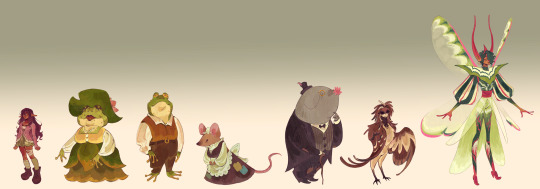

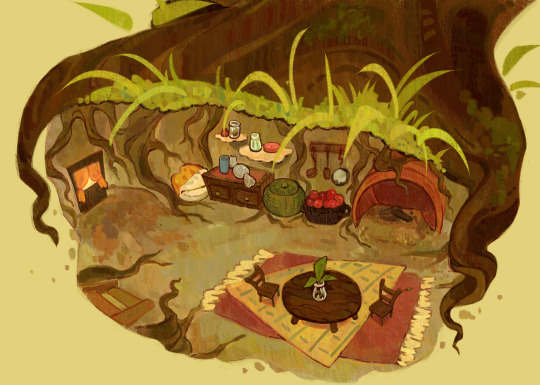
my rendition of thumbelina for my concept art class
617 notes
·
View notes
Text






not so interesting sketch dumps cause i feel guilty about not posting today, last one is mythological kyhuine dwarves ideas




maanul faces dump, trying to have ocs with difference faces lalala



sketches for a wip text about new infos around tahofahs and how theywork, concepts about "mind gates" and exchanging infos. its already figured, already tapped to some friends about it, i just need to redo my text to be clean and coherent for normal people here
shitposts



597 notes
·
View notes
Text
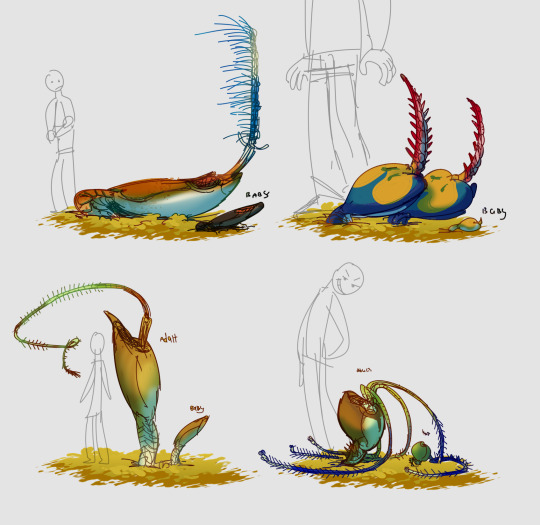
Slankats
Slankats are a wide group of Sinedenian parasitic heliophytes, most often found in areas with particularly thick foam grass layers which they parasitize on. It is the main host for the most slankats, although there are some exceptions.
This group of mixotrophs especially stands out from the rest, having a more animal-like appearance rather than the usual plant-like body plan. Some might confuse them with barnacles, due to their segmented tail and valved body with a feathery appendage.
They are highly specialized for parasitic lifestyle, to the point that some of them cannot produce their own nutrients by photosynthesis at all.
General anatomy of slankats
Their large bodies, despite their visual bulk, are actually very light and contain only a small number of tubular organs as well as a cavity for folding the stem into it. They attach to their hosts with the help of a scaly tail, at the end of which there is a spiked anchor with the bases of root organs on the sides. The roots of slankats are thin, long and highly branched, which allows them to absorb as many nutrients as possible from the foam grass.
At the top of the body there is a gill plate, with the help of which slankats breathe. Next to it there is a hole, from which emerges a flexible stem with genital organs growing on it (whip-flowers and chains of fruits).
The number of whips differs for different types of slankats (from 1 to 10). These whips carry female and male reproductive cells and unction similar to flowers on earth. When the whips are pollinated, after some time they wither away and in their place the fruits begin to grow, the number of which also varies. They can grow either in a chain or in a kind of bouquet.
Slancat fruits carry from two to ten embryos, and the fruit also contains chambers of gas that allow the fruit to fly away on wind currents or float on the surface of the water during floods (depending on the species, breeding cycle and season). When the fruit gets carried away to a fitting place, embryos emerge by popping out of the husk of the froot and then borrow into their host by using their tails.
132 notes
·
View notes
Text
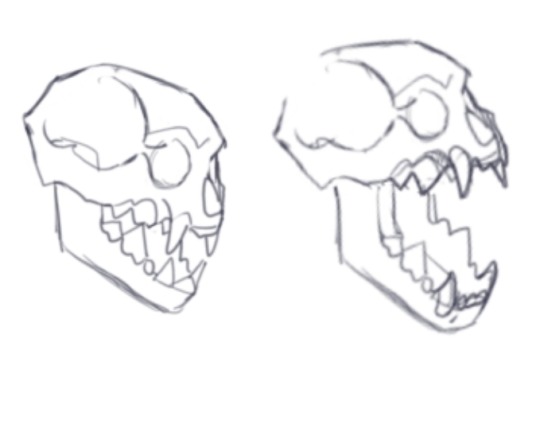
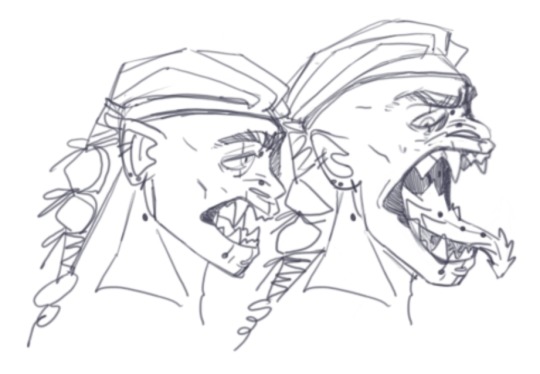
just some skull studies. h?man skulls are weird. adapted for crushing. I'm never consistant with their molars.
50 notes
·
View notes
Text

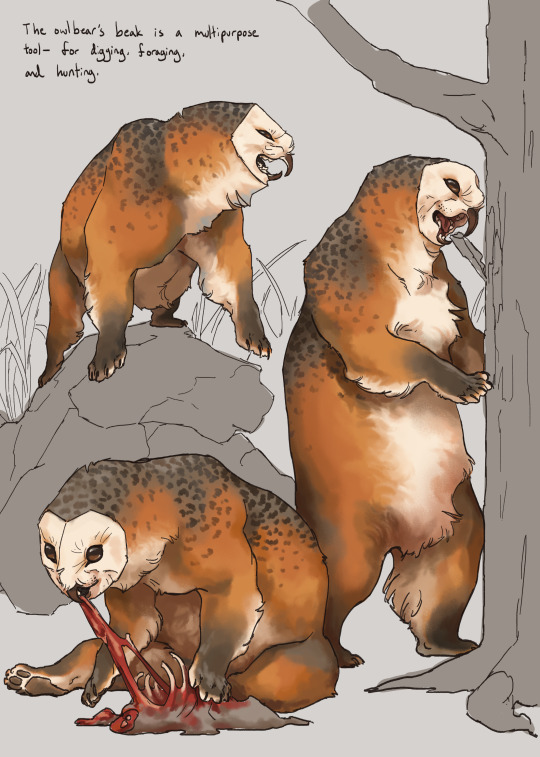

Despite its name, the owlbear is in fact neither owl nor bear - it is a large species of rodent whose external incisors resemble a curved "beak." The enamel of these incisors is colored brown because of iron compounds. This hard substance wears down at a slower rate than the regular tooth, thus producing a sharp edge at the tooth tip.
It is thought that owlbears are evolved from smaller burrowing rodents who made use of their external teeth as digging implements. Their ancestors lacked external pinnae, but the modern owlbear's fur grows in an owl-like facial disk to direct sound -- a case of convergent evolution.
Or, what if dnd owlbears were just big mole rats.
18K notes
·
View notes
Text

woe, elven mounts upon ye. just sketches
p.s. i will use the term "unicorn" for any animal whose antlers grow like this. this includes the herd in that southern "cowboy" post. they are all related in some way, but extremely varied depending on region. also pegasi eat bugs.
53 notes
·
View notes
Photo
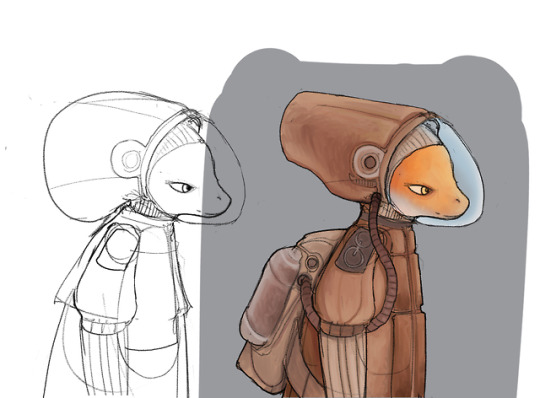
Lizard in Hazardous Environment Gear!
Useful deep in the ruins where the atmosphere is questionably breathable.
82 notes
·
View notes
Note
Where did the Artifacts/Ruins/Ancient Tech come from???
Hey! So sorry for the (extremely) late response.
The Shell and everything in it: artifacts, ruins, ancient tech, lizards, etc… Was shaped by an older civilization.
Calling it a “civilization” is actually a little misleading, because there were only a few dozen ‘individuals’ in total. Each one was a massive, sentient, colony of fungus. They experienced the world in a fundamentally alien way. They had no ears, eyes, or fingers, and communicated mostly through direct contact and chemical exchange. That’s why most ancient technology is so incomprehensible.
They’ve since left the Shell. Whether or not they’re totally extinct is unclear, but Lizards have never seen one.
31 notes
·
View notes
Photo

Lizard families are enormous, but food brings them together. Dinner is a chance for the administrators to mingle with the rank and file, a place to complain, flirt, catch up with friends, and engage in political intrigue. The kitchen and its intrepid staff makes this possible.
93 notes
·
View notes
Photo

Lizard skinscare! I’d type up a blurb, but it’s an infographic. So, you know, read it :p
Patreon reward for Match.
109 notes
·
View notes
Photo
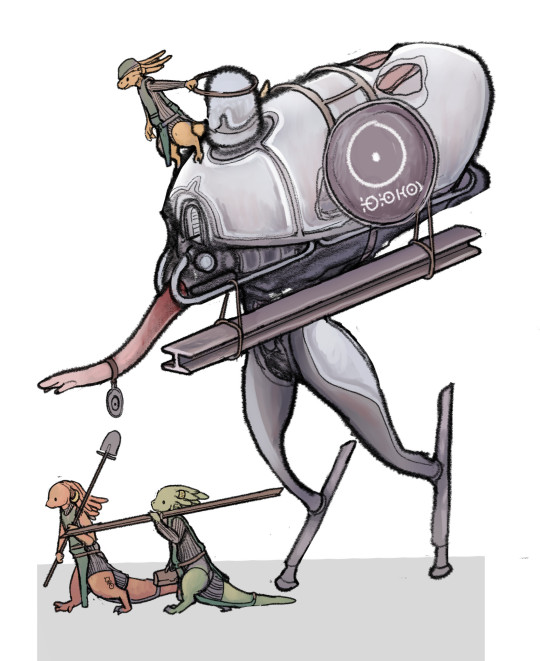
Lizards working with their Worm friend head to a construction site.
112 notes
·
View notes
Photo

i get the same question a lot… what IS the Shell?? Normal planet? megastructure? non-euclidean space? Well, now you know. It’s a Shell.
118 notes
·
View notes
